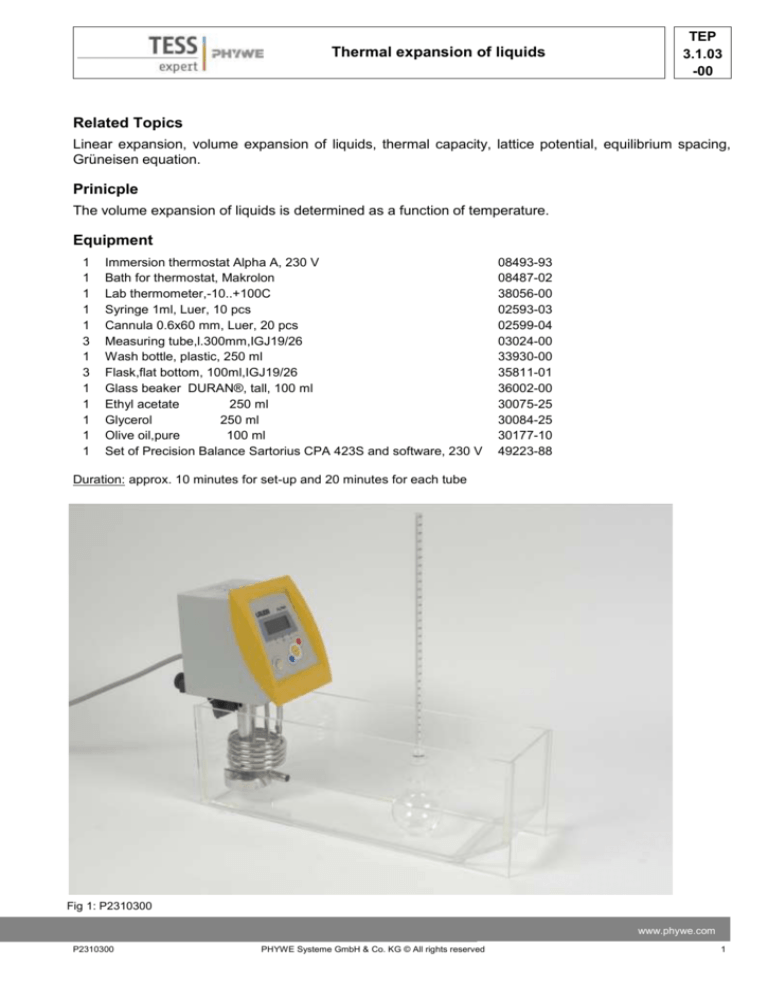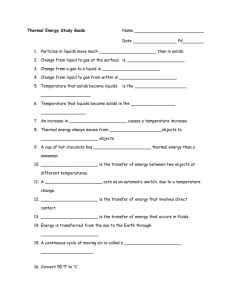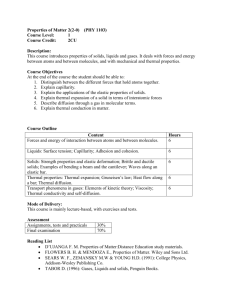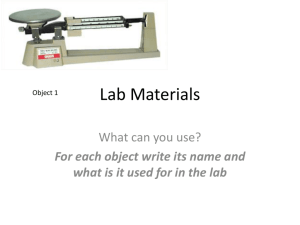
Thermal expansion of liquids
TEP
3.1.03
-00
Related Topics
Linear expansion, volume expansion of liquids, thermal capacity, lattice potential, equilibrium spacing,
Grüneisen equation.
Prinicple
The volume expansion of liquids is determined as a function of temperature.
Equipment
1
1
1
1
1
3
1
3
1
1
1
1
1
Immersion thermostat Alpha A, 230 V
Bath for thermostat, Makrolon
Lab thermometer,-10..+100C
Syringe 1ml, Luer, 10 pcs
Cannula 0.6x60 mm, Luer, 20 pcs
Measuring tube,l.300mm,IGJ19/26
Wash bottle, plastic, 250 ml
Flask,flat bottom, 100ml,IGJ19/26
Glass beaker DURAN®, tall, 100 ml
Ethyl acetate
250 ml
Glycerol
250 ml
Olive oil,pure
100 ml
Set of Precision Balance Sartorius CPA 423S and software, 230 V
08493-93
08487-02
38056-00
02593-03
02599-04
03024-00
33930-00
35811-01
36002-00
30075-25
30084-25
30177-10
49223-88
Duration: approx. 10 minutes for set-up and 20 minutes for each tube
Fig 1: P2310300
www.phywe.com
P2310300
PHYWE Systeme GmbH & Co. KG © All rights reserved
1
TEP
3.1.03
-00
Thermal expansion of liquids
Tasks
Determine the volume expansion of n-heptane (C7H16), olive oil and water as a function of temperature, using the
pycnometer.
Set-up
Set up the equipment as seen in
Fig 2: Procedure.
2
PHYWE Systeme GmbH & Co. KG © All rights reserved
P2310300
Thermal expansion of liquids
TEP
3.1.03
-00
Fig. 3: Potential curve as a function of the interatomic
spacing r.
Fig 1 (without pycnometer). Please refer to the manual of the thermostat for its installation and handling. The pycnometer is build from the flask and the measuring tube.
Procedure
Calibration
At the beginning the pycnometer must be calibrated, i.e. the relationship between the scale of the measurement tube and the volume must be determined.
Assemble the pycnometer using the flask and the measurement tube. Place the empty pycnometer on
the balance and set the balance to zero (Tara function). Now fill the pycnometer with water until the
scale of the measurement tube is reached and measure the mass. Increase the water amount in steps of
approximately 50 scale parts and measure the mass for each step. Note the results.
Measurement
Fill one of the three pycnometers with water, one with olive oil and one with heptane. Place one bottle in
the bath and note the initial Volume V0 and temperature T0. Now heat up the temperature bath and note
the volume at five temperature steps of 5°C each.
Note the results.
Theory and evaluation
An increase in temperature T causes the vibrational amplitude of the atoms in the crystal lattice of the
solid to increase. The potential curve (Fig. 3) of the bonding forces corresponds only to a first approximation to the parabola of a harmonic oscillation (dotted line); generally it is flatter in the case of large interatomic distances than in the case of small ones. If the vibrational amplitude is large, the centre of oscillation thus moves to larger interatomic distances. The average spacing between the atoms increases, as
well as the total volume V (at constant pressure p).
www.phywe.com
P2310300
PHYWE Systeme GmbH & Co. KG © All rights reserved
3
TEP
3.1.03
-00
Thermal expansion of liquids
1
𝜕𝑉
(1)
𝛼 = 𝑉 ∙ (𝜕𝑇 )
𝑃
is called the volume expansion coefficient; if we consider one dimension only, we obtain the coefficient of
linear expansion
𝛼1 =
1 𝜕𝑙
∙( )
𝑙 𝜕𝑇 𝑃
(2)
where l is the total length of the body.
A rise in the temperature causes a greater thermal agitation of the molecules in a liquid and therefore an
increase in its volume (water between 0 and 4°C is an exception to this, however).
The coefficient of expansion of olive oil and water depends on temperature. Measured values at 20°C
are:
liquid
α/10–3K–1
Water
0.20
Glycerol
0.50
Olive oil
0.72
Methylated spirit
1.11
Ethyl acetate
1.37
4
PHYWE Systeme GmbH & Co. KG © All rights reserved
P2310300
Thermal expansion of liquids
TEP
3.1.03
-00
Evaluation and Sample results
Calibration
First calculate the volume out of the mass by dividing the mass by the specific density of water. Select the right
density from Table 1.
Table 1: Calibration of the pycnometer
Scale
Mass in g
Volume in cm3
9
132.7
133.0
77
133.6
133.9
122
134.1
134.4
177
134.8
135.1
226
135.4
135.7
266
135.9
136.2
Temperature
in °C
Density in g/cm3
20
0,9982
25
0,9971
30
0,9956
35
0,9940
Plot the volume versus the scale. Fit a linear function for a later
calculation of the volume out of the scale.
Calibration function (in this case!): V = 0.0124 cm 3 ∙ Scaleparts
+ 133 cm3
Table 1: Density of water in dependence of the temperature
Fig. 2: Calibration of the pycnometer
www.phywe.com
P2310300
PHYWE Systeme GmbH & Co. KG © All rights reserved
5
TEP
3.1.03
-00
Thermal expansion of liquids
Measurement
Calculate T - T0 for each liquid and transform the volumes from Scale parts into cm 3 using the calibration function.
Water
Olive oil
Heptane
T in °C
V in Scale parts
T in °C
V in Scale parts
T in °C
V in Scale parts
T0 = 27
V0 = 2
T0 = 20
V0 = 8
T0 = 22
V0 = 12
32
8
25
14
27
25
37
14
30
27
32
67
42
34
35
48
37
124
47
52
40
76
42
187
52
73
45
107
47
254
Table 3: Expansion of the liquids
Liquid
Water
Olive oil
Heptane
T - T0 in °C
Volume in cm3
Volume in cm3
Volume in cm3
0
133.02
133.10
133.15
5
133.10
133.17
133.31
10
133.17
133.33
133.83
15
133.42
133.60
134.54
20
133.64
133.94
135.32
25
133.91
134.33
136.15
Table 4: Expansion of the liquids
Fig. 3 shows the thermal expansion of the liquids. The lines are straight fits to the data for calculation of the increment.
Get the increment for the data. For this neglect the first two measurement points, because the heating is inhomogeneous during the beginning of the measurement. According to the theory
1 V
V0 T
is valid. Therefore you have to divide the increment by the starting Volume V0.
Water
Olive oil
Heptane
Increment in cm3/K
0.0484
0.0664
0.155
V0
133.02
133.10
133.15
in 103/K
0.4
0.5
1.2
Theory
0.2
0.7
1.3
Table 5: Coefficients of linear expansion
6
PHYWE Systeme GmbH & Co. KG © All rights reserved
P2310300
Thermal expansion of liquids
TEP
3.1.03
-00
Fig. 3: Thermal expansion of the liquids (triangle up: heptane, circle: olive oil, triangle down: water)
Please note, that the theoretical values are for the standard temperature T = 20°C.
Note
The Grüneisen equation
𝛼
𝜅
=𝛾∙
𝐶𝑃
𝑉
(5)
Where
1 𝜕𝑉
𝜅=− ( )
𝑉 𝜕𝑝 𝑇
is the compressibility and
𝜕𝑈
𝐶𝑃 = ( )
𝜕𝑇 𝑃
is the thermal capacity of the solid (U = internal energy), signifies a relationship between the mechanical
and thermal properties of a solid. The Grüneisen parameter γ is defined by the change in the frequency
υ of lattice vibration with volume:
Δυ
Δ𝑉
= −𝛾
𝜐
𝑉
and can be calculated from macroscopic quantities in accordance with (5).
www.phywe.com
P2310300
PHYWE Systeme GmbH & Co. KG © All rights reserved
7








